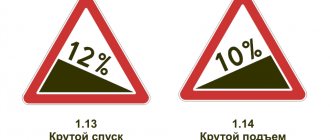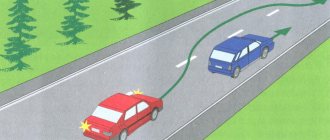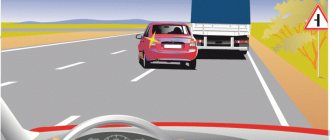Basic Concepts
The rules of the road clearly define concepts that are similar in everyday perception and do not at first glance have a significant difference.
These include:
- Overtaking is a temporary change of lane to the line of oncoming traffic with an increase in speed, in order to bypass the vehicle in front and then return to your path on a two-way highway.
- Advancement is a change in traffic lane for the purpose of overtaking, but without entering the oncoming lane.
- Changing lanes is a change in the trajectory of movement, that is, a transition from one path to another, but not accompanied by driving onto an oncoming road and not always associated with overtaking other cars.
Despite the obvious similarity of the concepts, it is worth noting that, unlike changing lanes and getting ahead, overtaking maneuvers are allowed only if certain conditions are met. Each maneuver must be accompanied by light and sound signals informing about the driver’s actions.
When driving, it is important not only to correctly interpret the content of road signs and markings, but also to classify your actions. This will allow you to avoid unpleasant sanctions and accidents due to negligence.
Advancing or overtaking
Car overtaking, according to the updated rules, is the same as getting ahead of a vehicle while simultaneously moving into the lane of oncoming traffic and then returning to its normal lane.
In other words, this action can be performed on the left side of the car.
As for aheading, according to the new rules, this is the movement of a car in which two vehicles overtake each other without the need to enter the oncoming lane.
There is also such a common concept as rebuilding . This is leaving an occupied lane or occupied row while fully maintaining the original direction of movement.
There are certain differences between these concepts. For example, ahead of a car can be done at absolutely any time, and overtaking is accompanied by certain prohibitive restrictions.
Overtaking on the right according to the 2021 traffic rules is strictly regulated. This cannot be done only at pedestrian crossings, at intersections, at railway crossings, as well as on tunnels and overpasses.
Every driver needs to distinguish between these concepts, regardless of driving experience . This is especially important for those who are not used to using conventional multi-lane roads, since misunderstanding and constant confusion between these concepts can lead to the creation of a large number of incidents caused by an attempt to overtake.
Video: Overtaking, getting ahead, oncoming traffic in simple words
Types of advance
Advancement is a more general concept than overtaking, since its main types include:
- Accelerating without changing lanes, which will actually be recognized as advancing, since the adjacent vehicle that was previously in front or to the side will be behind.
- Passing a vehicle in the left lane as a result of changing lanes from the extreme or middle lane.
- Overtaking associated with entering the oncoming line.
The list of acceptable types of lane changes is based on the fact that even at high speed limits there is no danger for road users.
The distinction between the concepts of overtaking and advancing occurred in 2010; before that, they actually meant the same thing. It is important for modern car enthusiasts to know not only the difference in terminology, but also how to behave.
Overtaking procedure
Overtaking is one of the most dangerous maneuvers that drivers make on the highway.
The fact is that at the moment of performing an action they become dependent on the actions of machines from both directions. Maximum concentration and concentration on the process is required so that everything goes smoothly and does not cause the need for other drivers to make emergency braking or turn. The main recommendations when overtaking include:
- turn on the turn signal to warn nearby vehicles that they are planning a maneuver;
- activate a more powerful gear so that the car can perform the manipulation;
- check whether overtaking will not interfere with other participants, for example, if the driver behind has already begun to make a maneuver, then you should let him pass;
- estimate the distance to cars driving in the oncoming lane in order to determine the temporary opportunity to complete the changeover into your lane.
You should not attempt to overtake on a hill, as visibility of oncoming traffic is limited. Also, in bad weather conditions there is a risk of not noticing other vehicles.
It is not recommended to overtake on narrow two-lane and mountain roads. In areas where it is difficult for two directions to pass each other, three cars driving at the same time will lead to a serious accident.
Penalty for violation
The concept of overtaking on the right does not exist, so there is no punishment for this action. If traffic police officers catch a driver driving on the side of the road or on a sidewalk, a penalty is imposed for this maneuver in the amount of 1,500 rubles.
If the fine is not paid within the prescribed period, the debt is transferred to the bailiffs. Then the driver will have to pay both the fine itself and a penalty in the amount of 200% of the amount collected.
Conscientious motorists can count on a discount from the state. This means that if the fine is paid within no more than twenty days from the date of the decision, the penalty for driving on the side of the road or on the sidewalk will be halved and amount to only 750 rubles.
If it is established that not only movement, but also advance along the side of the road, then the fine for such an action will be 5,000 rubles.
The same penalty is provided for overtaking on the right at an unregulated pedestrian crossing. If the passage of a pedestrian crossing is carried out in violation of the regulations, namely: without reducing the speed, driving into its borders, without allowing all pedestrians to pass, the law provides for a fine of 1,500 thousand.
If the above actions are repeated, the rights will be taken away for a year.
If the driver detours a vehicle along a pedestrian or bicycle path, or on a sidewalk, he will be charged 2,000 rubles.
If a maneuver involves driving into a continuous lane, he will be fined 5,000 rubles or have his driver’s license revoked for a period of four to six months.
Avoiding traffic jams in the right lane is unacceptable. It is also prohibited to become the second and third row on a single-lane road.
If movement along the side of the road occurs due to forced reasons (for example, damage to the road surface, a traffic accident or other immovable obstacle), no fines will be imposed.
While driving on the road, drivers must be extremely careful and follow the traffic rules. After all, the rules were created based on real cases, real emergencies and traffic accidents. In practice, misunderstanding of road rules or confusion of concepts such as overtaking, changing lanes and ahead can lead to disastrous results.
Leading on the right
Based on the definitions of the terms, overtaking and advancing, it follows that in Russia, with established left-hand traffic, such overtaking on the right does not exist, since this does not physically involve entering the oncoming lane. Such a maneuver will be considered ahead of the curve. There are no restrictions on changing lanes for the purpose of passing on the right in the traffic rules, but this does not mean that what is not prohibited is permitted. Overtaking on the right side of the road is not allowed, as this is contrary to other rules.
The norm for advance on the right is not highlighted separately due to the fact that the action taken will be associated with other violations.
These include:
- driving to the side of the road in order to get ahead of a vehicle traveling in the right lane;
- the vehicle speed in the right lane does not exceed the middle lane speed.
If a driver moves from the left or middle lane to the right, which is moving faster, then this will be considered a lane change. Changing lanes from the left lane will also be considered ahead if cars plan to make a turn there.
As for driving onto tram rails, this is prohibited, especially if it is associated with an attempt to overtake.
The traffic rules stipulate two situations in which this maneuver is permissible:
- Avoiding stopped vehicles that block traffic in an emergency.
- Driving during periods of increased traffic flow.
In both options, the driver must first make sure that his action will not interfere with the movement of the tram, since he has priority on the section of the road where the rails are located. Driving into the path of an oncoming tram is strictly punishable by law, as it constitutes several offenses at once: moving on the rails and in the oncoming lane.
An attempt to avoid a traffic jam on the highway on the side of the road is classified as a violation, moreover, such behavior leads to damage to the vehicle and will cause problems when changing lanes to the main lane.
Features of overtaking
If we talk about the classic formulation, overtaking a vehicle in front is allowed, but at the same time it is considered one of the dangerous maneuvers. It is required from a driver of a certain level of training. It is recommended to perform the following actions for this type of maneuver:
- initially turn on the left turn signal to draw the attention of other drivers to the fact that the person is about to change the trajectory;
- start a lower gear to preserve power reserves during the maneuver;
- use mirrors located in the center and sides of the car;
- estimate the distance between cars moving ahead and their speed;
- in the absence of interference, the driver begins to accelerate and enters the lane intended for oncoming traffic.
Performing this action on the right side is much more difficult. If we talk about such overtaking within the city, then on the right there may be tracks for trams, which are considered as a continuous line. Overtaking on the right on the tracks is permitted in some cases:
- to clear the road;
- when the bands are heavily filled.
Video: Overtaking, getting ahead, oncoming traffic
Sanctions
After defining the concept of overtaking on the right, let’s figure out what the fine is for the offense. As mentioned above, there is no violation of overtaking on the right and issuing a fine with this wording is illegal.
As a rule, the driver is punished for other administrative offenses:
- driving to the side of the road or sidewalk - one and a half thousand rubles;
- attempt to overtake in prohibited zones – five thousand rubles;
- driving on tram rails without objective circumstances – five thousand rubles or deprivation of a driver’s license for up to six months.
The degree of punishment is determined by how dangerous the situation became during the driver’s maneuver.
Overtaking on the side of the road involves a fine if it is proven that the purpose of changing lanes was to detour. Penalties are not imposed if, when leaving, the driver parked the vehicle and turned on the emergency stop signals. Also, traffic participants whose actions were caused by a difficult situation on the road will not be punished, for example:
- damage to the canvas, movement along which will aggravate the situation;
- Accidents in which part of the road is blocked.
If the road is narrow, then a partial drive to the side of the road is acceptable when driving towards a large vehicle.
Not only traffic police officers, but also CCTV cameras have the right to record an offense. Most fines today are based on video recordings.
When overtaking is prohibited
The Code of Administrative Offenses sets out all the situations when overtaking on the right side is prohibited under threat of a fine or deprivation of rights.
Article 12.18 of such overtaking includes the illegality of performing a maneuver near an unregulated pedestrian crossing, especially when the vehicle on the left begins to slow down, as this may indicate that a pedestrian is walking along the crossing.
It is prohibited to overtake on the right side in accordance with Part 1 of Art. 12.15 of the Code of Administrative Offenses of the Russian Federation is driving to the side of the road and then driving along it.
Overtaking on the right is prohibited if it entails entering bicycle and pedestrian paths, as well as sidewalks. Such a ban is regulated by Part 2 of Article 12.15 of the Code of Administrative Offenses of the Russian Federation.
You should not ignore Part 4 of Art. 12.15 of the Administrative Code, which provides for significant punishment for driving onto tram tracks with oncoming traffic. When they talk about overtaking on the right side, they mean the paths located to the right of the roadway.
Who has the right to overtake on the right?
The traffic rules clearly state that there is no violation of overtaking on the right as such, however, this maneuver is directly related to entering a prohibited area: the roadside and sidewalk.
Punishment is imposed under two articles:
- performing a maneuver contrary to the law;
- driving in a prohibited area.
The exception to the rule is cyclists. They are full participants in the road traffic and are required to comply with the rules and regulations. If the road does not have a dedicated lane for them, then cyclists have the right to ride on the side of the road. This presumption applies to persons over fourteen years of age.
All devices equipped with more powerful engines, including motorcycles, are treated like cars. They are equally influenced by the surface, weather conditions and conditions on the track.
Explanations for the overtaking maneuver on the right: when it is prohibited
In a constant rush, drivers want to gain as much time as possible on the road. In this regard, they have to resort to the most effective method in this case - overtaking. But is such a maneuver always harmless for other road users and unpunished for the performer? If we talk about overtaking on the right, then this is a controversial phenomenon in legal practice. If you violate strictly established rules for ahead of the car ahead on the right side, the driver creates a threat to himself in the form of a fine of 1,500 rubles. What violations does the legislation of the Russian Federation require for overtaking on the right? In what cases is this controversial maneuver allowed? And what is the responsibility for non-compliance with the rules? The answers to these exciting questions can be found in this article.











